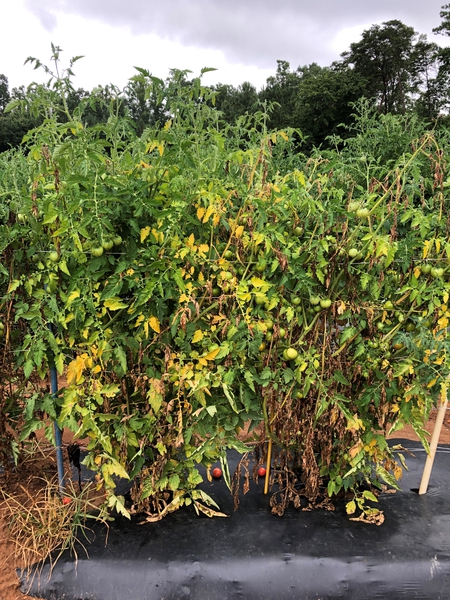Fusarium Wilt of Tomato
go.ncsu.edu/readext?809970
en Español / em Português
El inglés es el idioma de control de esta página. En la medida en que haya algún conflicto entre la traducción al inglés y la traducción, el inglés prevalece.
Al hacer clic en el enlace de traducción se activa un servicio de traducción gratuito para convertir la página al español. Al igual que con cualquier traducción por Internet, la conversión no es sensible al contexto y puede que no traduzca el texto en su significado original. NC State Extension no garantiza la exactitud del texto traducido. Por favor, tenga en cuenta que algunas aplicaciones y/o servicios pueden no funcionar como se espera cuando se traducen.
Português
Inglês é o idioma de controle desta página. Na medida que haja algum conflito entre o texto original em Inglês e a tradução, o Inglês prevalece.
Ao clicar no link de tradução, um serviço gratuito de tradução será ativado para converter a página para o Português. Como em qualquer tradução pela internet, a conversão não é sensivel ao contexto e pode não ocorrer a tradução para o significado orginal. O serviço de Extensão da Carolina do Norte (NC State Extension) não garante a exatidão do texto traduzido. Por favor, observe que algumas funções ou serviços podem não funcionar como esperado após a tradução.
English
English is the controlling language of this page. To the extent there is any conflict between the English text and the translation, English controls.
Clicking on the translation link activates a free translation service to convert the page to Spanish. As with any Internet translation, the conversion is not context-sensitive and may not translate the text to its original meaning. NC State Extension does not guarantee the accuracy of the translated text. Please note that some applications and/or services may not function as expected when translated.
Collapse ▲Fusarium wilt of tomato is caused by the soilborne fungus Fusarium oxysporum f. sp. lycopersici. Fusarium oxysporum f. sp. lycopersici mainly causes wilt on tomatoes, but it can infect many other plants including potatoes, peppers, eggplants, and legumes. Initially, symptoms of Fusarium wilt of tomato appear as one-sided wilting of only half of the plant, branch, or leaflet. At first, the plant will appear to recover from the wilt, but as the disease progresses, it will become permanent regardless of temperature or water status.

Lower leaves will become yellow first before chlorosis spreads to the higher branches, eventually leading to defoliation. Plant growth is typically stunted and few to no fruit develop. If the stem is cut open near the base of the plant, longitudinal light brown streaks can be seen within the vascular tissue (center of the inner stem). This discoloration can be slight and difficult to observe.
Look alike diseases. Other diseases that cause tomatoes to wilt include southern blight, bacterial wilt, and Verticillium wilt. However, the one-sided wilt or yellowing of the plant, leaf, and leaflet mentioned above are distinctive of Fusarium wilt.
Fusarium wilt can be difficult to manage once it is introduced and there is no known cure once it has become established within an area. However, there are preventative and disease reduction measures that can be implemented:
- Select resistant varieties. For fields with a history of Fusarium wilt, planting resistant varieties of tomato will inhibit severe symptoms. See the Southeastern US Vegetable Crop Handbook for a list of varieties with resistance. Seek guidance from a specialist to help identify which race is present in your field.
- Use grafted tomatoes. Tomato rootstocks that are resistant to Fusarium wilt are available and can be used with a susceptible scion variety. See vegetablegrafting.org for more information.
- Crop rotations for 3-5 years. Rotating away from tomato crops will reduce inoculum (spores) in the soil. This will not guarantee the elimination of disease, but will reduce the severity and incidence of infection on the subsequent crop. Weeds, such as pigweed, mallow, and crabgrass,can be hosts for the Fusarium wilt pathogen, so frequent maintenance of the infested area is necessary during this period of time.
- Only plant healthy transplants. Closely inspect transplants for symptoms of disease before planting to decrease the likelihood of introducing disease.
- Wash tractors and equipment between fields. Infested soil can be carried to other fields on equipment and tools. Frequent cleaning is highly recommended, particularly if moving from an infested field to a clean field.
- Use sterile potting media. If you are starting your own seedlings, use of a sterile soilless potting media is suggested to minimize the chance of introduction of the disease.
- Manage soil pH. Raising soil pH to a neutral range (6.5 – 7.0) by using lime will reduce the persistence of the pathogen.
- Avoid excessive nitrogen. High levels of nitrogen and low levels of potassium in the soil can increase a plant’s susceptibility to Fusarium wilt. Avoid over-application of high nitrogen fertilizers and use a soil test to determine nutrient levels.




